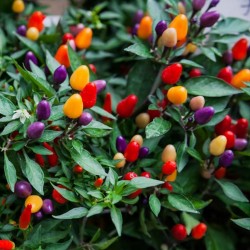Menu
-
MenuНазад
- Home
-
Категории
-
-
Категории
-
Растительные Семена
-
Сорта по стране
- Сорта из Армении
- Сорта из БиГ
- Сорта из Хорватии
- Сорта из Франции
- Сорта из Германии
- Сорта из Греции
- Сорта из Венгрии
- Сорта из Индии
- Сорта из Италии
- Сорта из Японии
- Сорта из Северной Македонии
- Сорта из Перу
- Сорта из россии
- Сорта из Сербии
- Сорта из Словении
- Сорта из Испании
- Сорта из Тайланда
- Сорта из Турции
- Сорта из США
- Семена томатов
- Семена кукурузы
- Семья тыквы
- Бобовая семья
- Семена огурца
- Семена перца
- Морковная семья
- Луковая семья
- Семена салата
- Картофельная семья
- Капустная семья
- Семена редьки
- Семья свеклы
- Семена Aрбуза
- Семена Дыни
- Цветная капуста Семена
- Подсолнечное семейство
-
Сорта по стране
- Фруктовые Семена
- Семена Перец Чили - Habanero
- Лекарственные травы Семена
- Вьющиеся растения семена
- Деревья Бонсай Семена
- Пальмовые семена
- Семена декоративных трав
- Семена табака
-
Растительные Семена
-
-
-
-
- НОВЫЕ ПРОДУКТЫ
- Доставка - Оплата
- Регистрация
- FAQ
- Главная
-
- Большие пакеты семян
- Семена гигантских растений
- Растительные Семена
- Сорта по стране
- Сорта из Армении
- Сорта из БиГ
- Сорта из Хорватии
- Сорта из Франции
- Сорта из Германии
- Сорта из Греции
- Сорта из Венгрии
- Сорта из Индии
- Сорта из Италии
- Сорта из Японии
- Сорта из Северной Македонии
- Сорта из Перу
- Сорта из россии
- Сорта из Сербии
- Сорта из Словении
- Сорта из Испании
- Сорта из Тайланда
- Сорта из Турции
- Сорта из США
- Семена томатов
- Семена кукурузы
- Семья тыквы
- Бобовая семья
- Семена огурца
- Семена перца
- Морковная семья
- Луковая семья
- Семена салата
- Картофельная семья
- Капустная семья
- Семена редьки
- Семья свеклы
- Семена Aрбуза
- Семена Дыни
- Цветная капуста Семена
- Подсолнечное семейство
- Сорта по стране
- Фруктовые Семена
- Семена Перец Чили - Habanero
- Лекарственные травы Семена
- Вьющиеся растения семена
- Деревья Бонсай Семена
- Семена банана
- Пальмовые семена
- Семена декоративных трав
- Семена табака
- Семена цветов
- Семена кактуса
- Семена водных растений
- Инструкция по посеву
- Фруктовые и овощные формы
- Грибной мицелий
- Завод Луковицы
- Семена бамбука
- Аюрведические растения
- Гибридные семена F1
- Упаковка и прочее
- Морозостойкие растения
- Уход за растениями
- Органические специи
- Доставка - Оплата
- Нет PayPal и оплаты картой X
Последние отзывы к продукту
Out of the two seeds, one germinated and the other one was dead and floatin...
От
 Riikka H на 07/03/2024
Riikka H на 07/03/2024
Проверенная покупка
Лидеры продаж
Товаров: 1294.
Показано 1276-1290 из 1294
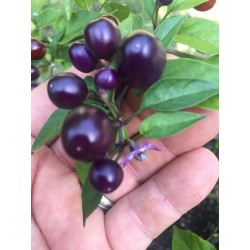
Chili 'Filius Blue' Seeds
Цена
8,50 €
(SKU: C 32)
Seeds Gallery EU,
5/
5
<h2><span style="text-decoration:underline;"><em><strong>Chili 'Filius Blue' Seeds</strong></em></span></h2>
<h3><span style="color:#ff0000;"><strong>Price for Package of 10 or 50 seeds.<br /></strong></span></h3>
<div>The Filius Blue is a beautiful ornamental and edible pepper. The Filius Blue has beautiful dark purple leaves. The peppers, which are growing upright, color from purple-blue to orange, yellow and end up red end when the pepper is ripe. This takes about 80 days after transplanting. De purple-blue pepper has more heat than the ripe red pepper. The plant will grow about 50 to 60 cm tall. The plant may be grown in vase. </div>
<div>
<table><tbody><tr><td><span style="color:#008000;">Official name:</span></td>
<td><span style="color:#008000;">Filius Blue</span></td>
</tr><tr><td><span style="color:#008000;">Species:</span></td>
<td><span style="color:#008000;">Annuum</span></td>
</tr><tr><td><span style="color:#008000;">Flower color:</span></td>
<td><span style="color:#008000;">White with purple</span></td>
</tr><tr><td><span style="color:#008000;">Fruit discoloration:</span></td>
<td><span style="color:#008000;">Dark purple</span><br /><span style="color:#008000;">Light purple</span><br /><span style="color:#008000;">Yellow orange</span><br /><span style="color:#008000;">Deep orange</span><br /><span style="color:#008000;">Bright red</span></td>
</tr><tr><td><span style="color:#008000;">Yield:</span></td>
<td><span style="color:#008000;">Very high</span></td>
</tr><tr><td><span style="color:#008000;">Harvest time min:</span></td>
<td><span style="color:#008000;">80</span></td>
</tr><tr><td><span style="color:#008000;">Plant height min:</span></td>
<td><span style="color:#008000;">50</span></td>
</tr></tbody></table></div>
C 32

- Только онлайн

Растение устойчиво к холоду и морозам

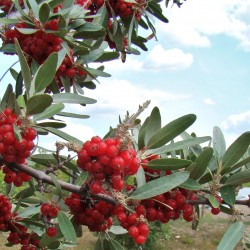
Russet Buffaloberry Seeds...
Цена
1,95 €
(SKU: V 64)
Seeds Gallery EU,
5/
5
<h2><strong>Russet Buffaloberry Seeds (Shepherdia canadensis)</strong></h2>
<h2><span style="color: #ff0000;"><strong>Price for Package of 5 seeds.</strong></span></h2>
<div>Hardy, Adaptable, Easy to Grow, Fast Growth, Edible Fruits, Attracts Birds, Wildlife Food/Shelter, Cold, Heat, Drought, Salt and Wind Tolerant, Nitrogen Fixing.</div>
<div> Shepherdia canadensis, also known as Russet Buffaloberry, Soopolallie, Soapberry, or Foamberry, is one of a small number of shrubs of the genus Shepherdia bearing edible red berries. The berries have an extremely bitter taste. The plant is a deciduous shrub found in open forests and thickets all over North America. Its northern limit is around the Arctic Circle. The shrub reaches a height of 3 to 13 feet. Fruits are extensively collected by some Canadian First Nations peoples such as Nlaka'pamux (Thompson), St̓átimc and Secwepemc (Shuswap) in the province of British Columbia. The bitter berries are not eaten directly but rather processed as sxusem ("sxushem") or "Indian ice-cream". Branches bearing fruit are hit with a stick and only the very ripe fruits that fall off are collected. A clean mat or tarpaulin is placed below the bush for collection. The berries are later placed into a great bowl that is absolutely free of oil or fat and are mixed with some sweet fruit such as raspberries. The mixture of berries is crushed and vigorously beaten in the manner of whipping cream in order to raise the typical foam of the sxusem confection. Sxusem has an agreeable blend of sweet and somewhat bitter tastes, possibly comparable to that encountered in sweetened coffee. The substance is believed by the First Nations peoples who prepare it to have many healthful properties, but the saponin chemicals making up the foam may also cause gastrointestinal irritation if consumed greatly. Native theme restaurants in British Columbia have occasionally had sxusem on the menu in recent years.</div>
<div>Leaf: Alternate, simple, elliptical to ovate, entire margins, 1 to 2 inches long, somewhat thickened dark green above with numerous silvery white scales, silvery white below with red-brown scales. </div>
<div>Flower: Dioecious; male and female flowers both light yellow-green, small (1/6 inch) and inconspicuous, appearing in early spring. </div>
<div>Fruit: A bright red drupe-like achene, 1/3 inch long and somewhat elongated, generally with a few silvery scales, ripen in mid to late summer and often occur in great abundance. </div>
<div>Twig: Slender, light brown and covered in numerous reddish brown, scruffy scales; buds stalked with valvate scales, flower buds more round. </div>
<div>Bark: Shiny reddish gray with numerous lenticels that develop into larger cracks and splits. </div>
<div>Form: A small shrub reaching up to 6 feet in height (occasionally much larger) with a dense rounded crown.</div>
<div>Other Names: Russet Buffaloberry, Russet Buffalo berry, Hippophae canadensis, Rabbitberry, Foamberry Soapberry, Soopalollie, Canadian Buffaloberry</div>
<div>Zone: 2 to 6</div>
<div>Growth Rate: Fast</div>
<div>Plant Type: Deciduous Shrub</div>
<div>Family: Elaeagnaceae</div>
<div>Height: 6 to 8 feet</div>
<div>Spread: 6 to 8 feet</div>
<div>Shape: Upright, rounded</div>
<div>Bloom Time: April-May</div>
<div>Bloom Color: Yellow</div>
<div>Flower/Fruit: Small, inconspicuous, yellow flowers are followed by yellowish-red, oval-shaped fruits.</div>
<div>Sun: Sun-Part Shade</div>
<div>Drought Tolerance: High</div>
<div>Water: Medium</div>
<div>Maintenance: Medium</div>
<div>Site Requirements/ Soil Tolerances: Easily grown in average, medium, well-drained soil in full sun to part shade. Tolerates wide range of soils. Very hardy and adaptable. Give it plenty of room to spread.</div>
<div>Culture: Can be pruned to a small tree. Remove root suckers and runners to control any unwanted spread of the plant. To keep it at a low height, cut it back to knee high every 5 to 10 years. If it gets too leggy, it can be cut back to the ground and it will come back bushier and with more berries the next year.</div>
<div>Uses: Wildlife shelter, screens, windbreaks. Naturalize in open woodland areas where it can be allowed to spread. Erosion control on slopes. Native plant gardens. Informal hedge. Good for dry, salty, high-pH soils, such as along highways.</div>
<div>
<table cellspacing="0" cellpadding="0" border="1">
<tbody>
<tr>
<td colspan="2" width="100%" valign="top">
<p><span style="color: #008000;"><strong>Sowing Instructions</strong></span></p>
</td>
</tr>
<tr>
<td valign="top" nowrap="nowrap">
<p><span style="color: #008000;"><strong>Propagation:</strong></span></p>
</td>
<td valign="top">
<p><span style="color: #008000;">Seeds</span></p>
</td>
</tr>
<tr>
<td valign="top" nowrap="nowrap">
<p><span style="color: #008000;"><strong>Pretreat:</strong></span></p>
</td>
<td valign="top">
<p><span style="color: #008000;">Pour Hot water over seed. Soak in water for 24 hours</span></p>
</td>
</tr>
<tr>
<td valign="top" nowrap="nowrap">
<p><span style="color: #008000;"><strong>Stratification:</strong></span></p>
</td>
<td valign="top">
<p><span style="color: #008000;">3 months in moist sowing mix at 2-5 ° C refrigerator</span></p>
</td>
</tr>
<tr>
<td valign="top" nowrap="nowrap">
<p><span style="color: #008000;"><strong>Sowing Time:</strong></span></p>
</td>
<td valign="top">
<p><span style="color: #008000;">all year round</span></p>
</td>
</tr>
<tr>
<td valign="top" nowrap="nowrap">
<p><span style="color: #008000;"><strong>Sowing Depth:</strong></span></p>
</td>
<td valign="top">
<p><span style="color: #008000;">1 cm</span></p>
</td>
</tr>
<tr>
<td valign="top" nowrap="nowrap">
<p><span style="color: #008000;"><strong>Sowing Mix:</strong></span></p>
</td>
<td valign="top">
<p><span style="color: #008000;">Coir or sowing mix + sand or perlite</span></p>
</td>
</tr>
<tr>
<td valign="top" nowrap="nowrap">
<p><span style="color: #008000;"><strong>Germination temperature:</strong></span></p>
</td>
<td valign="top">
<p><span style="color: #008000;">min. 20 ° C</span></p>
</td>
</tr>
<tr>
<td valign="top" nowrap="nowrap">
<p><span style="color: #008000;"><strong>Location:</strong></span></p>
</td>
<td valign="top">
<p><span style="color: #008000;">bright + keep constantly moist not wet</span></p>
</td>
</tr>
<tr>
<td valign="top" nowrap="nowrap">
<p><span style="color: #008000;"><strong>Germination Time:</strong></span></p>
</td>
<td valign="top">
<p><span style="color: #008000;">until it germinates </span></p>
</td>
</tr>
<tr>
<td valign="top" nowrap="nowrap">
<p><span style="color: #008000;"><strong>Watering:</strong></span></p>
</td>
<td valign="top">
<p><span style="color: #008000;">Water regularly during the growing season</span></p>
</td>
</tr>
<tr>
<td valign="top" nowrap="nowrap">
<p><span style="color: #008000;"><strong> </strong></span></p>
</td>
<td valign="top">
<p><br /><span style="color: #008000;"><em>Copyright © 2012 Seeds Gallery - Saatgut Galerie - Galerija semena. </em><em>All Rights Reserved.</em><em></em></span></p>
</td>
</tr>
</tbody>
</table>
</div>
V 64 (5 S)

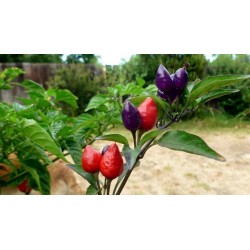
Chili Numex Centennial Seeds
Цена
1,50 €
(SKU: C 38)
Seeds Gallery EU,
5/
5
<h2><span style="text-decoration:underline;"><em><strong><span style="line-height:1.5em;">Chili Numex Centennial Seeds</span></strong></em></span></h2>
<h3><strong><span style="line-height:1.5em;color:#ff0000;">Price for Package of 5 seeds.</span></strong><span style="font-size:10pt;"><strong><span style="line-height:1.5em;color:#ff0000;"><br /></span></strong></span></h3>
<div><span style="font-size:10pt;line-height:1.5em;">This was the first ornamental variety released from NMSU intended for growing in small containers. It was released in 1988 to celebrate NMSU's Centennial celebrations. Many seed companies offer seed of this cultivar, unfortunately, under different names. 'NuMex Centennial' has purple flowers and purple foliage. The upright fruits are purple, then ripen to yellow, orange, and finally red. Very similar in appearence to the Bolivian Rainbow.</span></div>
<div><span style="font-size:10pt;line-height:1.5em;">Species: Annuum</span></div>
<div>Origin: New Mexico</div>
C 38


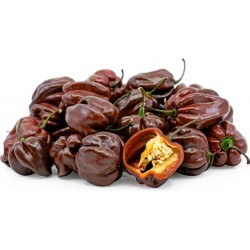
Habanero Шоколад Семена
Цена
2,00 €
(SKU: C 19 C)
Seeds Gallery EU,
5/
5
<h2>Habanero Шоколад Семена</h2>
<h2><span style="color:#ff0000;">Цена за пакет из 5 семян.</span></h2>
<p>Без сомнения, все знают, что такое шоколад, и если вы хоть немного любите перец, то хотя бы слышали о хабанеро. Но шоколадный хабанеро - отнюдь не конфета с перцем, как можно было бы заключить из такого названия. Это по-настоящему огненный чили, который некоторое время даже считался самым жгучим в мире. В спелом состоянии его плоды приобретают красивый темно-коричневый цвет, но их экзотический вкус с оттенками земли и дыма, демонстрирующий типичную для хабанеро сладость, не имеет ничего общего с шоколадом. Коричневые хабанеро существенно превосходят<span> </span>оранжевые<span> </span>по остроте. Их рейтинг по<span> </span>шкале Сковилла<span> </span>составляет от 425.000 до 577.000 единиц, тогда как обычный<span> </span>хабанеро<span> </span>может похвастаться максимум 350.000 единиц. Аромат шоколадной разновидности также куда более интенсивен - темный, густой и обволакивающий, он несет в себе дух Карибских островов.</p>
<p>Этот перец весьма популярен в карибской кухне. Его используют для приготовления соусов, маринадов, чатни, рагу, барбекю, пиццы и даже тортов. Он входит в классический рецепт знаменитого ямайского соуса джерк и представляет собой идеальный чили для моле и сальсы, где особенно хорошо сочетается с абрикосами и изюмом. Небольшое количество шоколадного хабанеро полностью меняет вкус всего блюда. Абсолютный «must eat» для всех любителей острой еды.</p>
<h4><strong>Распространение и экология</strong></h4>
<p>Шоколадный хабанеро предположительно появился около 5000 года до нашей эры в Центральной Америке, откуда затем попал в Мексику и на Карибские острова. На языке науатль он изначально назывался словом xocolātl, но когда британские торговцы специями впервые покупали его в 1880 году, то для благозвучности превратили xocolātl в «шоколад». Этот чили также известен как черный хабанеро.</p>
<p>Сегодня различные сорта шоколадного хабанеро выращиваются в тропических регионах по всему миру. К самым популярным из них относятся Jamaican Chocolate, Senegal Hot Chocolate и Congo Black.</p>
<h4><strong>Ботаническое описание</strong></h4>
<p>Растение высотой около 1 м с зелеными стеблями и листьями и кремово-желтыми цветами. Плоды немного крупнее и более шаровидной формы, чем у обычного хабанеро, 5 см в длину и 4 см в диаметре, с морщинистой кожицей, при созревании становятся темно-коричневыми.</p>
<h4><strong>Выращивание</strong></h4>
<p>Черный хабанеро растет значительно медленнее, чем другие разновидности этого чили. Лучше всего себя чувствует в тропическом климате. Предпочитает слабокислые почвы и любит солнце по утрам. Плоды вызревают примерно через 100 дней после пикировки рассады.</p>
C 19 C

- Только онлайн

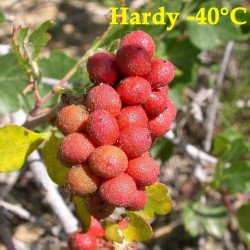
Skunkbush сумах семена...
Цена
2,90 €
(SKU: V 49)
Seeds Gallery EU,
5/
5
<h2><strong>Skunkbush сумах семена экзотических фруктов (rhus trilobata)<br /></strong></h2>
<h2><span style="color: #ff0000;"><strong>Цена за пакет из 5 семян.</strong></span></h2>
<div>A low deciduous shrub that offers attractive flowers in spring and bright fruits and foliage in fall, skunkbush sumac is native to western North America. In mid-spring before the leaves emerge, conspicuous clusters of pale yellow flowers appear at the stem tips. Small berries follow, ripening red in late summer. Resembling poison ivy foliage, the downy three-lobed leaves are mildly glossy and medium to dark green. The leaflets have blunt-toothed edges. Bruised leaves release a malodorous scent. In autumn, the foliage turns fiery colors. </div>
<div>Skunkbush sumac does best in full sun and moderately moist soil, with the brightest autumn color produced under such conditions. In drier soil plants are smaller. Use this extremely hardy shrub as a loose low screen at the edge of a woodland or building, or to clothe a bank or other erosion-prone site. Plants may sucker and form a thicket in some conditions.</div>
<div> </div>
<div>Genus: Rhus </div>
<div>Species: trilobata</div>
<div>Common Name: Skunkbush Sumac</div>
<div>Other Name: Schamltzia trilobata, Rhus Canadensis var. Trilobata, Quailbush</div>
<div>Pre-treatment: required</div>
<div>Zone Hardiness Cold: 4</div>
<div>Zone Hardiness warm: 7</div>
<div>Plant Type: Small Shrub</div>
<div>Height / Width: 1-2m/2-3m</div>
<div>Growth rate: medium</div>
<div>Vegetation type: decidious</div>
<div>Leaf /Flower color: green/yellow-green</div>
<div>Light</div>
<div>Conditions : Light Conditions </div>
<div>Unless a site is completely exposed, light conditions will change during the day and even during the year. The northern and eastern sides of a house receive the least amount of light, with the northern exsposure being the shadiest. The western and southern sides of a house receive the most light and are conidered the hottest exposures due to intense afternoon sun.</div>
<div>You will notice that sun and shade patterns change during the day. The western side of a house may even be shady due to shadows cast by large trees or a structure from an adjacent property. If you have just bought a new home or just beginning to garden in your older home, take time to map sun and shade throughout the day. You will get a more accurate feel for your site's true light conditions. </div>
<div> </div>
<div>Conditions : Full to Partial Sun </div>
<div>Full sunlight is needed for many plants to assume their full potential. Many of these plants will do fine with a little less sunlight, although they may not flower as heavily or their foliage as vibrant. Areas on the southern and western sides of buildings usually are the sunniest. The only exception is when houses or buildings are so close together, shadows are cast from neighboring properties. Full sun usually means 6 or more hours of direct unobstructed sunlight on a sunny day. Partial sun receives less than 6 hours of sun, but more than 3 hours. Plants able to take full sun in some climates may only be able to tolerate part sun in other climates. Know the culture of the plant before you buy and plant it! </div>
<div> </div>
<div>Watering</div>
<div>Conditions : Moist and Well Drained </div>
<div>Moist and well drained means exactly what it sounds like. Soil is moist without being soggy because the texture of the soil allows excess moisture to drain away. Most plants like about 1 inch of water per week. Amending your soil with compost will help improve texture and water holding or draining capacity. A 3 inch layer of mulch will help to maintain soil moisture and studies have shown that mulched plants grow faster than non-mulched plants. </div>
<div> </div>
<div>Planting</div>
<div>How-to : Planting Shrubs </div>
<div>Dig a hole twice the size of the root ball and deep enough to plant at the same level the shrub was in the container. If soil is poor, dig hole even wider and fill with a mixture half original soil and half compost or soil amendment.</div>
<div>Carefully remove shrub from container and gently separate roots. Position in center of hole, best side facing forward. Fill in with original soil or an amended mixture if needed as described above. For larger shrubs, build a water well. Finish by mulching and watering well.</div>
<div> </div>
<div>If the plant is balled-and-burlapped, remove fasteners and fold back the top of natural burlap, tucking it down into hole, after you've positioned shrub. Make sure that all burlap is buried so that it won't wick water away from rootball during hot, dry periods. If synthetic burlap, remove if possible. If not possible, cut away or make slits to allow for roots to develop into the new soil. For larger shrubs, build a water well. Finish by mulching and watering well.</div>
<div>If shrub is bare-root, look for a discoloration somewhere near the base; this mark is likely where the soil line was. If soil is too sandy or too clayey, add organic matter. This will help with both drainage and water holding capacity. Fill soil, firming just enough to support shrub. Finish by mulching and watering well. </div>
<div> </div>
<div>Problems</div>
<div>Diseases : Verticillium or Fusarium Wilt </div>
<div>Wilts may be contracted through infected seed, plant debris, or soil. This fungus begins and multiplies during the cool, moist season, becoming obvious when weather turns warm and dry. Plants wilt because the fungus damages their water conducting mechanisms. Overfertilization can worsen this problem. Able to overwinter in soil for many years, it is also carried and harbored in common weeds.</div>
<div> </div>
<div>Prevention and Control: If possible, select resistant varieties. Keep nitrogen-heavy fertilizers to a minimum as well as over-irrigating as they encourage lush growth. Practice crop rotation and prune out or better yet remove infected plants. </div>
<div> </div>
<div>Fungi : Powdery Mildew </div>
<div>Powdery Mildew is usually found on plants that do not have enough air circulation or adequate light. Problems are worse where nights are cool and days are warm and humid. The powdery white or gray fungus is usually found on the upper surface of leaves or fruit. Leaves will often turn yellow or brown, curl up, and drop off. New foliage emerges crinkled and distorted. Fruit will be dwarfed and often drops early.</div>
<div>Prevention and Control: Plant resistant varieties and space plants properly so they receive adequate light and air circulation. Always water from below, keeping water off the foliage. This is paramount for roses. Go easy on the nitrogen fertilizer. Apply fungicides according to label directions before problem becomes severe and follow directions exactly, not missing any required treatments. Sanitation is a must - clean up and remove all leaves, flowers, or debris in the fall and destroy. </div>
<div> </div>
<div>Pest : Caterpillars </div>
<div>Caterpillars are the immature form of moths and butterflies. They are voracious feeders attacking a wide variety of plants. They can be highly destructive and are characterized as leaf feeders, stem borers, leaf rollers, cutworms and tent-formers.</div>
<div>Prevention and Control: keep weeds down, scout individual plants and remove caterpillars, apply labeled insecticides such as soaps and oils, take advantage of natural enemies such as parasitic wasps in the garden and use Bacillus thuringiensis (biological warfare) for some caterpillar species. </div>
<div> </div>
<div>Fungi : Leaf Spots </div>
<div>Leaf spots are caused by fungi or bacteria. Brown or black spots and patches may be either ragged or circular, with a water soaked or yellow-edged appearance. Insects, rain, dirty garden tools, or even people can help its spread.</div>
<div>Prevention and Control: Remove infected leaves when the plant is dry. Leaves that collect around the base of the plant should be raked up and disposed of. Avoid overhead irrigation if possible; water should be directed at soil level. For fungal leaf spots, use a recommended fungicide according to label directions.</div>
<div> </div>
<div>Pest : Scale Insects </div>
<div>Scales are insects, related to mealybugs, that can be a problem on a wide variety of plants - indoor and outdoor. Young scales crawl until they find a good feeding site. The adult females then lose their legs and remain on a spot protected by its hard shell layer. They appear as bumps, often on the lower sides of leaves. They have piercing mouth parts that suck the sap out of plant tissue. Scales can weaken a plant leading to yellow foliage and leaf drop. They also produce a sweet substance called honeydew (coveted by ants) which can lead to an unattractive black surface fungal growth called sooty mold.</div>
<div>Prevention and Control: Once established they are hard to control. Isolate infested plants away from those that are not infested. Cosnult your local garden center professional or Cooperative Extension office in your county for a legal recommendation regarding their control. Encourage natural enemies such as parasitic wasps in the garden. </div>
<div> </div>
<div>Miscellaneous</div>
<div>Conditions : Deer Tolerant </div>
<div>There are no plants that are 100% deer resistant, but many that are deer tolerant. There are plants that deer prefer over others. You will find that what deer will or will not eat varies in different parts of the country. A lot of it has to do with how hungry they are. Most deer will sample everything at least once, decide if they like it or not and return if favorable. A fence is the good deer barrier. You may go for a really tall one (7 to 8 feet), or try 2 parallel fences, (4 to 5 feet apart). Use a wire mesh fence rather than board, since deer are capable of wiggling through a 12 inch space. </div>
<div> </div>
<div>Conditions : Pollution Tolerant </div>
<div>Air pollution is becoming a bigger problem each day. Pollutants in our air damage plants. The plants are damaged by absorbing sulfur dioxide, ozone, peroxyacetyl nitrate, ethylene, and nitrogen dioxide through their pores. Cell membrane damage may result in leaf drop, blotched or burnt looking leaves, or off-colored tissue between veins. Vehicles and industrial processes are the key culprits and conditions worsen on hot summer days. Though planting only pollution tolerant plants is not the solution to this problem, it is a visual bandaid. Your Cooperative Extension Service may have a list of plants that are more pollution tolerant in your area. </div>
<div> </div>
<div>Conditions : Rabbit Tolerant </div>
<div>As cute as they are, rabbits can really damage a vegetable garden. Young, tender lettuce plants seem to be their favorite. If a free-roaming dog is not a possiblility for you, consider installing raised vegetable beds and covering tender shoots with netting. If you have ample room, you can opt to plant enough for you and the bunnies. Scents don't always repel animals, as they get used to them and are often washed off in the rain. </div>
<div> </div>
<div>Conditions : Slope Tolerant </div>
<div>Slope tolerant plants are those that have a fibrous root system and are often plants that prefer good soil drainage. These plants assist in erosion control by stabilizing/holding the soil on slopes intact. </div>
<div> </div>
<div>Conditions : Wind Tolerant </div>
<div>Plants that are wind tolerant usually have flexible, strong branches that are not brittle. Wind tolerant plants often have thick or waxy leaves that control moisture loss from whipping winds. Native plants are often the best adapted to not only wind, but also soil and other climatic conditions. </div>
<div> </div>
<div>Conditions : Fall Color </div>
<div>Fall color is the result of trees or shrubs changing colors according to complex chemical formulas present in their leaves. Depending on how much iron, magnesium, phosphorus, or sodium is in the plant, and the acidity of the chemicals in the leaves, leaves might turn amber, gold, red, orange or just fade from green to brown. Scarlet oaks, red maples and sumacs, for instance, have a slightly acidic sap, which causes the leaves to turn bright red. The leaves of some varieties of ash, growing in areas where limestone is present, will turn a regal purplish-blue.</div>
<div> </div>
<div>Although many people believe that cooler temperatures are responsible for the color change, the weather has nothing to do with it at all. As the days grow shorter and the nights longer, a chemical clock inside the trees starts up, releasing a hormone which restricts the flow of sap to each leaf. As fall progresses, the sap flow slows and chlorophyll, the chemical that gives the leaves their green color in the spring and summer, disappears. The residual sap becomes more concentrated as it dries, creating the colors of fall. </div>
<div> </div>
<div>Glossary : Deciduous </div>
<div>Deciduous refers to those plants that lose their leaves or needles at the end of the growing season. </div>
<div> </div>
<div>Glossary : Shrub </div>
<div> </div>
<div>Shrub: is a deciduous or evergreen woody perennial that has multiple branches that form near its base. </div>
<div> </div>
<div>Glossary : Heat Zone </div>
<div>The 12 zones of the AHS Heat Zone map indicate the average number of days each year that a given region experiences ""heat days"" or temperatures over 86 degrees F(30 degrees Celsius). That is the point at which plants begin suffering physiological damage from heat. The zones range from Zone 1 (less than one heat day) to Zone 12 (more than 210 heat days). The AHS Heat Zone, which deals with heat tolerance, should not be confused with the USDA Hardiness Zone system which deals with cold tolerance. For example: Seattle, Washington has a USDA Hardiness Zone of 8, the same as Charleston, South Carolina; however Seattle's Heat Zone is 2 where Charleston's Heat Zone is 11. What this says is that winter temperature in the two cities may be similar, but because Charleston has significantly warmer weather for a longer period of time, plant selection based on heat tolerance is a factor to consider. </div>
<div> </div>
<div>Glossary : Plant Characteristics </div>
<div>Plant characteristics define the plant, enabling a search that finds specific types of plants such as bulbs, trees, shrubs, grass, perennials, etc. </div>
<div> </div>
<div>Glossary : Medium Shrub </div>
<div>A medium shrub is generally between 3 and 6 feet tall. </div>
<div> </div>
<div>Glossary : Flower Characteristics </div>
<div>Flower characteristics can vary greatly and may help you decide on a ""look or feel"" for your garden. If you're looking for fragrance or large, showy flowers, click these boxes and possibilities that fit your cultural conditions will be shown. If you have no preference, leave boxes unchecked to return a greater number of possibilities. </div>
<div> </div>
<div>Glossary : Foliage Characteristics </div>
<div>By searching foliage characteristics, you will have the opportunity to look for foliage with distinguishable features such as variegated leaves, aromatic foliage, or unusual texture, color or shape. This field will be most helpful to you if you are looking for accent plants. If you have no preference, leave this field blank to return a larger selection of plants. </div>
<div> </div>
<table border="1" cellspacing="0" cellpadding="0">
<tbody>
<tr>
<td colspan="2" valign="top" width="100%">
<p><span style="color: #008000;"><strong>Sowing Instructions</strong></span></p>
</td>
</tr>
<tr>
<td valign="top" nowrap="nowrap">
<p><span style="color: #008000;"><strong>Propagation:</strong></span></p>
</td>
<td valign="top">
<p><span style="color: #008000;">Seeds</span></p>
</td>
</tr>
<tr>
<td valign="top" nowrap="nowrap">
<p><span style="color: #008000;"><strong>Pretreat:</strong></span></p>
</td>
<td valign="top">
<p><span style="color: #008000;">pour over with hot water + Soak about 24 hrs</span></p>
</td>
</tr>
<tr>
<td valign="top" nowrap="nowrap">
<p><span style="color: #008000;"><strong>Stratification:</strong></span></p>
</td>
<td valign="top">
<p><span style="color: #008000;">0</span></p>
</td>
</tr>
<tr>
<td valign="top" nowrap="nowrap">
<p><span style="color: #008000;"><strong>Sowing Time:</strong></span></p>
</td>
<td valign="top">
<p><span style="color: #008000;">all year round</span></p>
</td>
</tr>
<tr>
<td valign="top" nowrap="nowrap">
<p><span style="color: #008000;"><strong>Sowing Depth:</strong></span></p>
</td>
<td valign="top">
<p><span style="color: #008000;">Just lightly cover with substrate</span></p>
</td>
</tr>
<tr>
<td valign="top" nowrap="nowrap">
<p><span style="color: #008000;"><strong>Sowing Mix:</strong></span></p>
</td>
<td valign="top">
<p><span style="color: #008000;">Coir or sowing mix + sand or perlite</span></p>
</td>
</tr>
<tr>
<td valign="top" nowrap="nowrap">
<p><span style="color: #008000;"><strong>Germination temperature:</strong></span></p>
</td>
<td valign="top">
<p><span style="color: #008000;">min. 20 ° C</span></p>
</td>
</tr>
<tr>
<td valign="top" nowrap="nowrap">
<p><span style="color: #008000;"><strong>Location:</strong></span></p>
</td>
<td valign="top">
<p><span style="color: #008000;">bright + keep constantly moist not wet</span></p>
</td>
</tr>
<tr>
<td valign="top" nowrap="nowrap">
<p><span style="color: #008000;"><strong>Germination Time:</strong></span></p>
</td>
<td valign="top">
<p><span style="color: #008000;">until it germinates </span></p>
</td>
</tr>
<tr>
<td valign="top" nowrap="nowrap">
<p><span style="color: #008000;"><strong>Watering:</strong></span></p>
</td>
<td valign="top">
<p><span style="color: #008000;">Water regularly during the growing season</span></p>
</td>
</tr>
<tr>
<td valign="top" nowrap="nowrap">
<p><span style="color: #008000;"><strong> </strong></span></p>
</td>
<td valign="top">
<p><br /><span style="color: #008000;"><em>Copyright © 2012 Seeds Gallery - Saatgut Galerie - Galerija semena. </em><em>All Rights Reserved.</em><em></em></span></p>
<div><span style="color: #008000;"><em> </em></span></div>
</td>
</tr>
</tbody>
</table>
V 49 (5 S)

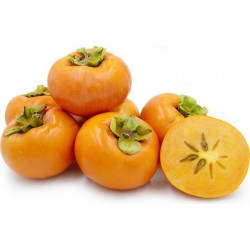
Семена Хурма американская...
Цена
3,50 €
(SKU: V 25 A)
Seeds Gallery EU,
5/
5
<h2 class=""><strong>Семена Хурма виргинская, Хурма американская (Diospyros virginiana)</strong></h2>
<h2><span style="color: #ff0000;"><strong>Цена за пакет из 5 семян.</strong></span></h2>
<p><b>Хурма виргинская</b><sup id="cite_ref-_9e7357623f0620ff_2-0" class="reference">[2]</sup>, или<span> </span><b>Хурма американская</b><span> </span>(лат. <span lang="la">Diospyros virginiana</span>) —<span> </span>растение<span> </span>семейства<span> </span>Эбеновые<span> </span>(<i><span lang="la">Ebenaceae</span></i>), вид рода<span> </span>Хурма, произрастающее в восточной части<span> </span>США.<span> </span>Ареал<span> </span>вида простирается от<span> </span>Новой Англии<span> </span>на севере до<span> </span>Флориды<span> </span>на юге и от<span> </span>Атлантического океана<span> </span>на востоке до<span> </span>Техаса,<span> </span>Канзаса<span> </span>и<span> </span>Оклахомы<span> </span>на западе. Культивируется в пределах ареала, а также в<span> </span>Средиземноморье,<span> </span>Гвиане<span> </span>и на<span> </span>Яве. В США носит название «common persimmon» («хурма обыкновенная»)<sup id="cite_ref-3" class="reference">[3]</sup><sup id="cite_ref-4" class="reference">[4]</sup>. Впервые описана по результатам экспедиции<span> </span>Эрнандо де Сото<span> </span>в Северную Америку (1539—1543)<sup id="cite_ref-_85975bce0244f5b6_5-0" class="reference">[5]</sup>.</p>
<h2><span class="mw-headline" id="Биологическое_описание">Биологическое описание</span></h2>
<table align="left" cellspacing="0" cellpadding="2">
<tbody>
<tr bgcolor="#DDEEDD" align="center" valign="middle">
<td>
<div class="center">
<div class="floatnone"><img alt="Семена Хурма виргинская, Хурма американская (Diospyros virginiana)" src="https://upload.wikimedia.org/wikipedia/commons/thumb/a/a6/Persimmon_0375.jpg/120px-Persimmon_0375.jpg" decoding="async" width="120" height="104" srcset="//upload.wikimedia.org/wikipedia/commons/thumb/a/a6/Persimmon_0375.jpg/180px-Persimmon_0375.jpg 1.5x, //upload.wikimedia.org/wikipedia/commons/thumb/a/a6/Persimmon_0375.jpg/240px-Persimmon_0375.jpg 2x" data-file-width="300" data-file-height="259" title="Семена Хурма виргинская, Хурма американская (Diospyros virginiana)" /></div>
</div>
</td>
</tr>
<tr bgcolor="#DDEEDD" align="center" valign="top">
<td colspan="11">
<div>Цветок Хурмы виргинской</div>
</td>
</tr>
</tbody>
</table>
<p>Это — небольшое листопадное<span> </span>дерево<span> </span>высотой до 20 м с тёмно-серой или коричневатой корой. Растение двудомное, хотя некоторые экземпляры однодомные. Живёт до 100—150 лет.</p>
<p>Листья крупные длиной 15,2 см, кожистые, овальной формы с сердцевидной основой и заострённым концом.</p>
<p>Цветки<span> </span>однополые, опыляются насекомыми или ветром.</p>
<p>Плод<span> </span>ягодовидный с сочной мякотью. Семена с тонкой кожурой и очень твёрдым<span> </span>эндоспермом.</p>
<p>Светолюбива. Предпочитает защищённые от ветра участки. Зимостойка, переносит морозы до −25…-30 °C, иногда до −37 °C. Почвы предпочитает кислые и нейтральные (pH 5-8) лёгкие. Влаголюбива, но мирится с сухостью почвы. Корневая система глубокая стержневая.</p>
<h2><span id=".D0.98.D1.81.D0.BF.D0.BE.D0.BB.D1.8C.D0.B7.D0.BE.D0.B2.D0.B0.D0.BD.D0.B8.D0.B5"></span><span class="mw-headline" id="Использование">Использование</span></h2>
<div class="thumb tleft">
<div class="thumbinner"><img alt="Семена Хурма виргинская, Хурма американская (Diospyros virginiana)" src="https://upload.wikimedia.org/wikipedia/commons/thumb/c/c7/Persimmon.jpg/220px-Persimmon.jpg" decoding="async" width="220" height="146" class="thumbimage" srcset="//upload.wikimedia.org/wikipedia/commons/thumb/c/c7/Persimmon.jpg/330px-Persimmon.jpg 1.5x, //upload.wikimedia.org/wikipedia/commons/thumb/c/c7/Persimmon.jpg/440px-Persimmon.jpg 2x" data-file-width="1024" data-file-height="681" title="Семена Хурма виргинская, Хурма американская (Diospyros virginiana)" />
<div class="thumbcaption">
<div class="magnify"></div>
Американское дерево хурмы, несущее плоды осенью</div>
</div>
</div>
<p>Плоды хурмы виргинской съедобны и по своей питательности стоя́т выше всех других плодов умеренной зоны<sup id="cite_ref-_9e7357623f0620ff_2-1" class="reference">[2]</sup>. В её плодах содержится до 44 %<span> </span>сахара, пектин,<span> </span>яблочная кислота<span> </span>и другие компоненты. Плоды используются в сыром виде, как сухофрукты и для кондитерских изделий. До XVI века индейцы готовили из плодов пиво и водку. Может идти на корм для свиней и служить источником дубильных веществ. Обжаренные и измельчённые семена хурмы виргинской использовались населением<span> </span>штатов Юга<span> </span>и солдатами армии Конфедерации во время<span> </span>Гражданской войны в США<span> </span>как заменитель кофе<sup id="cite_ref-_85975bce0244f5b6_5-1" class="reference">[5]</sup>. Главное использование в настоящее время — как декоративное растение и как<span> </span>подвой<span> </span>для<span> </span><i>Diospyros kaki</i>. Растение отличается высокой урожайностью, невзыскательностью, переносит морозы до -25 или -30° С.</p>
V 25 A (2 S)


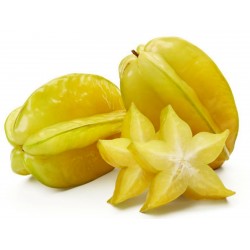
Карамбо́ла Семена (лат....
Цена
4,00 €
(SKU: V 9 AC)
Seeds Gallery EU,
5/
5
<h2>Карамбо́ла Семена (лат. Averrhoa carambola)</h2>
<h2><span style="color: #ff0000;">Цена за пакет из 2 семян.</span></h2>
<p><b style="font-size: 14px;">Карамбо́ла</b><span style="font-size: 14px;"> </span><span style="font-size: 14px;">(</span><span style="font-size: 14px;">лат.</span><span style="font-size: 14px;"> </span><span lang="la" style="font-size: 14px;" xml:lang="la">Averrhoa carambola</span><span style="font-size: 14px;">) — вечнозелёное</span><span style="font-size: 14px;"> </span><span style="font-size: 14px;">дерево</span><span style="font-size: 14px;">, произрастающее на</span><span style="font-size: 14px;"> </span><span style="font-size: 14px;">Шри-Ланке</span><span style="font-size: 14px;">, в</span><span style="font-size: 14px;"> </span><span style="font-size: 14px;">Индии</span><span style="font-size: 14px;"> </span><span style="font-size: 14px;">и</span><span style="font-size: 14px;"> </span><span style="font-size: 14px;">Индонезии</span><span style="font-size: 14px;">, а ныне также распространённое в Южной и</span><span style="font-size: 14px;"> </span><span style="font-size: 14px;">Юго-Восточной Азии</span><span style="font-size: 14px;">,</span><span style="font-size: 14px;"> </span><span style="font-size: 14px;">вид</span><span style="font-size: 14px;"> </span><span style="font-size: 14px;">рода</span><span style="font-size: 14px;"> </span><span style="font-size: 14px;">Аверроа</span><span style="font-size: 14px;"> </span><span style="font-size: 14px;">семейства</span><span style="font-size: 14px;"> </span><span style="font-size: 14px;">Кисличные</span><span style="font-size: 14px;">.</span></p>
<div>
<p>Акклиматизировано в<span> </span>Бразилии,<span> </span>Гане,<span> </span>Гвиане,<span> </span>Французской Полинезии,<span> </span>США<span> </span>(в штатах<span> </span>Флорида,<span> </span>Гавайи),<span> </span>Израиле.</p>
<table align="left" cellspacing="0" cellpadding="2">
<tbody>
<tr bgcolor="#FFFFFF" align="center">
<td>
<div class="center">
<div class="floatnone"><img alt="" src="https://upload.wikimedia.org/wikipedia/commons/thumb/6/62/Averrhoa_carambola_ARS_k5735-7.jpg/180px-Averrhoa_carambola_ARS_k5735-7.jpg" width="180" height="269"></div>
</div>
</td>
</tr>
<tr bgcolor="#FFFFFF" align="center">
<td>
<div class="center">
<div class="floatnone"><img alt="" src="https://upload.wikimedia.org/wikipedia/commons/thumb/a/a3/Carambola_cut.jpg/180px-Carambola_cut.jpg" width="180" height="87"></div>
</div>
</td>
</tr>
<tr bgcolor="#FFFFFF" align="center">
<td>
<div>Плоды карамболы</div>
</td>
</tr>
</tbody>
</table>
<h2><span></span><span class="mw-headline">Биологическое описание</span></h2>
<p>Карамбола имеет сложные<span> </span>акациевидные<span> </span>листья до 50 см длиной, розовые цветки. Крона густая, дерево достигает в высоту пяти метров. В отличие от большинства тропических растений, карамболе не нужно много света. Как у всех кисличных, пластинки листьев складываются при прикосновении. Дерево влаголюбиво, но может выращиваться и в домашних условиях. Цветок у карамболы актиноморфный (5 чашелистиков и 5 лепестков) и обоеполый, завязь верхняя. Плод: ягода.</p>
<h2><span></span><span class="mw-headline">Применение</span></h2>
<p>Плоды карамболы известны под названиями «тропические звёзды», «старфруты», обычно жёлтого или жёлто-коричневого цвета. Плод глянцевый жёлто-зелёный ребристый, в поперечном разрезе образующий пятиконечную звезду. Плоды хрустящие, сочные и бывают кисло-сладкие или сладкие с массивными ребристыми наростами. Являются источником<span> </span>витамина С. Период созревания карамболы начинается в мае и заканчивается в августе.<br>Используют карамболу, в основном, для украшений<span> </span>коктейлей<span> </span>или<span> </span>десертов.<br>Вкус: своеобразный<sup id="cite_ref-karamb_3-0" class="reference">[3]</sup>. Карамболу можно хранить в холодильнике до трёх недель<sup id="cite_ref-karamb_3-1" class="reference">[3]</sup>.</p>
<h2><span></span><span class="mw-headline">Противопоказания</span></h2>
<p>Людям, страдающим<span> </span>энтероколитом,<span> </span>гастритом<span> </span>или<span> </span>язвенной болезнью желудка<span> </span>и<span> </span>двенадцатиперстной кишки, особенно на острой стадии, есть карамболу не рекомендуется из-за присутствия<span> </span>щавелевой кислоты<span> </span>в значительных концентрациях. В больших количествах употребление этих фруктов может спровоцировать развитие почечной патологии или привести к нарушению солевого обмена в организме.</p>
<h2><span></span><span class="mw-headline">Как домашнее растение</span></h2>
<p>Карамбола легко выращивается из семечка, в домашних условиях обычно образует плакучую форму, неприхотлива и теневынослива, но боится холодных сквозняков зимой. Полив средний, не влаголюбива, но и не засухоустойчива.</p>
</div>
<div></div>
<div>
<table border="1" cellspacing="0" cellpadding="0">
<tbody>
<tr>
<td colspan="2" valign="top" width="100%">
<p><span style="color: #008000;"><strong>Sowing Instructions</strong></span></p>
</td>
</tr>
<tr>
<td valign="top" nowrap="nowrap">
<p><span style="color: #008000;"><strong>Propagation:</strong></span></p>
</td>
<td valign="top">
<p><span style="color: #008000;">Seeds </span></p>
</td>
</tr>
<tr>
<td valign="top" nowrap="nowrap">
<p><span style="color: #008000;"><strong>Pretreat:</strong></span></p>
</td>
<td valign="top">
<p><span style="color: #008000;">0</span></p>
</td>
</tr>
<tr>
<td valign="top" nowrap="nowrap">
<p><span style="color: #008000;"><strong>Stratification:</strong></span></p>
</td>
<td valign="top">
<p><span style="color: #008000;">0</span></p>
</td>
</tr>
<tr>
<td valign="top" nowrap="nowrap">
<p><span style="color: #008000;"><strong>Sowing Time:</strong></span></p>
</td>
<td valign="top">
<p><span style="color: #008000;">all year round</span></p>
</td>
</tr>
<tr>
<td valign="top" nowrap="nowrap">
<p><span style="color: #008000;"><strong>Sowing Depth:</strong></span></p>
</td>
<td valign="top">
<p><span style="color: #008000;">0.5 - 1 cm</span></p>
</td>
</tr>
<tr>
<td valign="top" nowrap="nowrap">
<p><span style="color: #008000;"><strong>Sowing Mix:</strong></span></p>
</td>
<td valign="top">
<p><span style="color: #008000;">Coir or sowing mix + sand or perlite</span></p>
</td>
</tr>
<tr>
<td valign="top" nowrap="nowrap">
<p><span style="color: #008000;"><strong>Germination temperature:</strong></span></p>
</td>
<td valign="top">
<p><span style="color: #008000;">about 22-25 ° C.</span></p>
</td>
</tr>
<tr>
<td valign="top" nowrap="nowrap">
<p><span style="color: #008000;"><strong>Location:</strong></span></p>
</td>
<td valign="top">
<p><span style="color: #008000;">bright + keep constantly moist not wet</span></p>
</td>
</tr>
<tr>
<td valign="top" nowrap="nowrap">
<p><span style="color: #008000;"><strong>Germination Time:</strong></span></p>
</td>
<td valign="top">
<p><span style="color: #008000;">3-6 weeks</span></p>
</td>
</tr>
<tr>
<td valign="top" nowrap="nowrap">
<p><span style="color: #008000;"><strong>Watering:</strong></span></p>
</td>
<td valign="top">
<p><span style="color: #008000;">Water regularly during the growing season</span></p>
</td>
</tr>
<tr>
<td valign="top" nowrap="nowrap">
<p><span style="color: #008000;"><strong> </strong></span></p>
</td>
<td valign="top">
<p><br><em><strong><span style="color: #008000;">Copyright © 2012 Seeds Gallery - Galerija semena. All Rights Reserved.</span></strong></em></p>
</td>
</tr>
</tbody>
</table>
</div><script src="//cdn.public.n1ed.com/G3OMDFLT/widgets.js"></script>
V 9 AC (2 S)

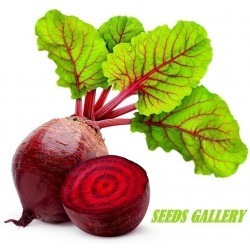
Beetroot 100 Seeds - Egyptian
Цена
1,15 €
(SKU: VE 230)
Seeds Gallery EU,
5/
5
<h2 class=""><strong>100 Seeds Egyptian Beetroot (Beta vulgaris)</strong></h2>
<h2 class=""><span style="color: #ff0000;"><strong>Price for Package of 100 seeds.</strong></span></h2>
<div>Heirloom variety dating back to 1800’s that produces a flattish beetroot with dark red flesh that has lighter zones. Excellent old fashioned flavour, eaten raw or cooked. Delicious edible tops</div>
<div>stay green and can be used as spinach or in salads. Early variety. 55 days.</div>
<script src="//cdn.public.n1ed.com/G3OMDFLT/widgets.js"></script>
VE 230 (1,5g)

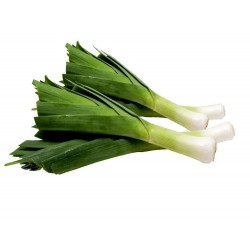
Семян Камуса Лука-Порея
Цена
1,75 €
(SKU: MHS 148)
Seeds Gallery EU,
5/
5
<h2 class="h1 product-detail-name"><strong>Семян Камуса Лука-Порея</strong></h2>
<h2 class="h1 product-detail-name"><strong><span style="color: #ff0000;">Цена за пакет из 320 (1g) семян.</span></strong></h2>
<p>Лук-порей, который находится в одной семье с луком и чесноком, имеет сходный вкус с другими знакомыми овощами в этой семье. Этот вкусный овощ, который обычно используется в качестве основного ингредиента в супах и бульонах, придает любому сердечному блюду прекрасный луковичный, землистый вкус.</p>
<p>Это очень устойчивое растение, и оно может легко противостоять зимней погоде, пока они не будут готовы к уборке.<br>От посева этих семян до полного созревания обычно занимает около 4 месяцев, а прорастание - 2-3 недели.</p>
<div id="idTab1" class="rte">
<table cellspacing="0" cellpadding="0" border="1">
<tbody>
<tr>
<td colspan="2" width="100%" valign="top">
<p><span style="color: #008000;"><strong>Sowing Instructions</strong></span></p>
</td>
</tr>
<tr>
<td valign="top" nowrap="nowrap">
<p><span style="color: #008000;"><strong>Propagation:</strong></span></p>
</td>
<td valign="top">
<p><span style="color: #008000;">Seeds</span></p>
</td>
</tr>
<tr>
<td valign="top" nowrap="nowrap">
<p><span style="color: #008000;"><strong>Pretreat:</strong></span></p>
</td>
<td valign="top">
<p><span style="color: #008000;">0</span></p>
</td>
</tr>
<tr>
<td valign="top" nowrap="nowrap">
<p><span style="color: #008000;"><strong>Stratification:</strong></span></p>
</td>
<td valign="top">
<p><span style="color: #008000;">0</span></p>
</td>
</tr>
<tr>
<td valign="top" nowrap="nowrap">
<p><span style="color: #008000;"><strong>Sowing Time:</strong></span></p>
</td>
<td valign="top">
<p><span style="color: #008000;">all year round </span></p>
</td>
</tr>
<tr>
<td valign="top" nowrap="nowrap">
<p><span style="color: #008000;"><strong>Sowing Depth:</strong></span></p>
</td>
<td valign="top">
<p><span style="color: #008000;">1 cm</span></p>
</td>
</tr>
<tr>
<td valign="top" nowrap="nowrap">
<p><span style="color: #008000;"><strong>Sowing Mix:</strong></span></p>
</td>
<td valign="top">
<p><span style="color: #008000;">Coir or sowing mix + sand or perlite</span></p>
</td>
</tr>
<tr>
<td valign="top" nowrap="nowrap">
<p><span style="color: #008000;"><strong>Germination temperature:</strong></span></p>
</td>
<td valign="top">
<p><span style="color: #008000;">+16 / +25°C</span></p>
</td>
</tr>
<tr>
<td valign="top" nowrap="nowrap">
<p><span style="color: #008000;"><strong>Location:</strong></span></p>
</td>
<td valign="top">
<p><span style="color: #008000;">bright + keep constantly moist not wet</span></p>
</td>
</tr>
<tr>
<td valign="top" nowrap="nowrap">
<p><span style="color: #008000;"><strong>Germination Time:</strong></span></p>
</td>
<td valign="top">
<p><span style="color: #008000;">2-3 weeks</span></p>
</td>
</tr>
<tr>
<td valign="top" nowrap="nowrap">
<p><span style="color: #008000;"><strong>Watering:</strong></span></p>
</td>
<td valign="top">
<p><span style="color: #008000;">Water regularly during the growing season</span></p>
</td>
</tr>
<tr>
<td valign="top" nowrap="nowrap">
<p><span style="color: #008000;"><strong> </strong></span></p>
</td>
<td valign="top">
<p><br><span style="color: #008000;"><em>Copyright © 2012 Seeds Gallery - Saatgut Galerie - Galerija semena. </em><em>All Rights Reserved.</em><em></em></span></p>
<div></div>
</td>
</tr>
</tbody>
</table>
</div>
<div id="idTab5" class="block_hidden_only_for_screen">
<p class="align_center">No customer comments for the moment.</p>
<p class="align_center">Only registered users can post a new comment.</p>
</div><script src="//cdn.public.n1ed.com/G3OMDFLT/widgets.js"></script>
MHS 148 (1g)

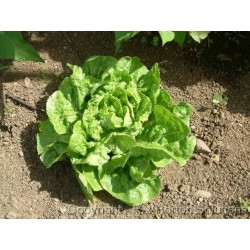
Lettuce Seeds 'Green...
Цена
1,50 €
(SKU: PL 1)
Seeds Gallery EU,
5/
5
<h2><strong>Lettuce Seeds 'Green Mignonette' Butterhead</strong></h2>
<h2 class=""><span style="color: #f80000;"><strong>Price for Package of 100 (0,09g) seeds.</strong></span></h2>
<div>Green Mignonette' is a butterhead lettuce type. It is an excellent home garden variety as it is easy to grow with exceptional eating qualities and is slow to bolt. It has soft, deep green, ruffled leaves, a loose heart and is very tender and sweet. It is suitable for planting for most of the year. Days to harvest: 25 days salad mix; 46 days full size.</div><script src="//cdn.public.n1ed.com/G3OMDFLT/widgets.js"></script>
PL 1 (100 S)

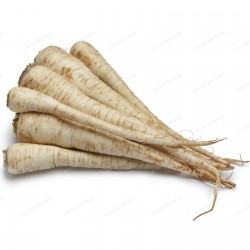
Семена петрушки корневой...
Цена
1,95 €
(SKU: VE 24 (1,4g))
Seeds Gallery EU,
5/
5
<h2><strong>Семена петрушки корневой Берлинская</strong></h2>
<h2><span style="color: #ff0000;" class=""><strong>Цена за пакет из 1000+ (1,4g) семян.</strong></span></h2>
<p>Позднеспелый сорт корневой петрушки со сроками спелости от 150 дней и до 180. У растения образуется раскидистая розетка и конусовидный корнеплод с заостренным кончиком. Диаметр корня Берлинской петрушки достигает 4 см, длина – до 20 см.</p>
<p>Это один из моих любимых корнеплодов. Зелень петрушки, конечно, тоже хороша, ем её много в свежем виде, но в сушёном она уже не имеет аромата, потому и перестала её заготавливать. А вот корень – совсем другое дело, в нём больше питательности, витаминов, и они сохраняются до середины зимы. Корень петрушки и сладок, и ароматен. Его хорошо просто грызть в сыром виде.</p>
<script src="//cdn.public.n1ed.com/G3OMDFLT/widgets.js"></script>
VE 24 (1,4g)

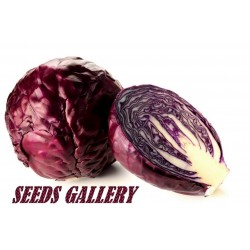
Red Cabbage Seeds
Цена
1,85 €
(SKU: VE 23 (1g))
Seeds Gallery EU,
5/
5
<h2><strong>Red Cabbage Seeds - Brassica oleracea var. capitata</strong></h2>
<h2><span style="color: #ff0000;"><strong>Price for Package of 200 (1g) seeds.</strong></span></h2>
<div class="">This popular deep red compact variety is a heavy producer of tasty round 6-7 inch solid round heads. The traditional cabbage for pickling but is perfect as a colourful and flavoursome winter vegetable or shred finely and add to salads. They have good holding ability or can be stored for a few months. Cabbages are easy to grow, and can keep the whole family fed all year round. It can be eaten fresh or cooked and has an excellent source of vitamin C.</div><script src="//cdn.public.n1ed.com/G3OMDFLT/widgets.js"></script>
VE 23 (1g)

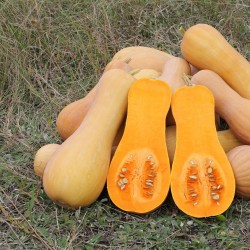
Organic Butternut Pumpkin...
Цена
4,15 €
(SKU: VG 16)
Seeds Gallery EU,
5/
5
<h2><span style="text-decoration:underline;"><em><strong>Organic Butternut Pumpkin seeds</strong></em></span></h2>
<h3><span style="color:#ff0000;"><strong>Price for Package of 10 or 40 seeds. </strong></span></h3>
<div>Very versatile with a sweet nutty taste. <span style="font-size:11px;line-height:1.5em;">Delicious as a roast or steamed vegetable or as an alternative to pumpkin in pies, roasts or soups. </span></div>
<div> Sow seeds in clumps of 3-5 seeds, spacing each clump 60cm (2ft) apart. Place the seeds on their edges to ensure they don't rot and keep moist. </div>
<div> Thin to the strongest seedling in each group when they emerge.</div>
<div>Harvest when the stalks become dry.</div>
<div>Fruits store for 3-4 months if kept dry not damaged.</div>
VG 16 (40 S)


Растение устойчиво к холоду и морозам
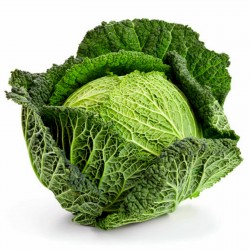
Семена капусты савойской...
Цена
1,85 €
(SKU: VE 89 KV (1g))
Seeds Gallery EU,
5/
5
<h2 class=""><strong>Семена капусты савойской ВЕРТУС (Vertus)</strong></h2>
<h2><span style="color: #ff0000;"><strong>Цена пакета 300 (1 г) семян.</strong></span></h2>
<p>80 дней до созревания. Савойская капуста наиболее холодовыносливая из всех видов капусты, имеет очень тонкие, взъерошенные бугорчатые листья, более тонкий аромат в отличии от обычной капусты. Большие, зеленые кочаны весят в среднем 2-3 кг и идеально подходят для начинки, тушения и приготовления супов, и также для консервирования. Избегайте чрезмерного полива.</p>
<h3><strong>Посев:</strong></h3>
<p>Семена в квартирах нужно начинать очень рано весной для раннего летнего урожая или за 6+ недель до первого осеннего сильного мороза для зимнего урожая. Капуста лучше всего справляется с хорошей почвой для быстрого роста, лучше всего с последующим оплодотворением. Лучше всего держать равномерно влажным - используйте мульчу. Мелко возделывать в течение первых нескольких недель. Сорта савойи очень холодостойкие.</p>
VE 89 KV (1g)





